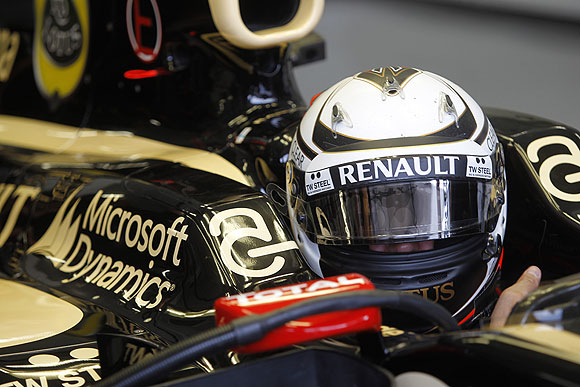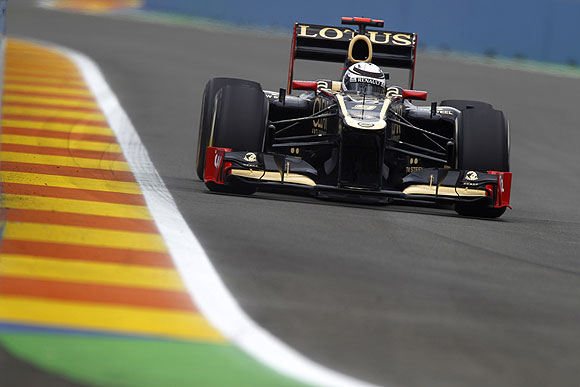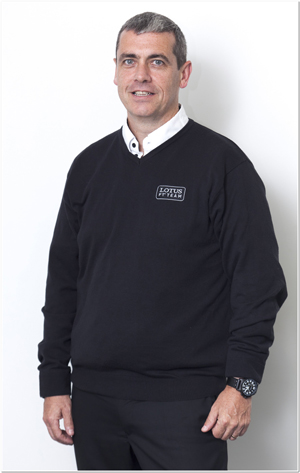REDMOND, Wash. — August 30, 2012 — Blink during the next Formula 1 race, and you might miss the Microsoft Dynamics logo zooming by at 212 mph. But the team whose car bears the logo hopes everyone will get a much better look when it’s parked in the winner’s circle.

August 29, 2012
The Lotus F1 Team is partnering with Microsoft Dynamics to help it win the 2014 Formula 1 World Championship.
This spring, the Lotus F1 Team and Microsoft announced a three-year partnership that stamped the Microsoft Dynamics name on the team’s cars and its drivers’ overalls. But the deal goes well beyond logos. The Lotus F1 Team is using Microsoft Dynamics AX to help fine-tune and drive every aspect of its business, from managing the design, manufacturing and testing of the 20,000-plus parts on each car to analyzing real-time data from the racetrack.
The partnership is a key part of the racing team’s business transformation aimed at winning the 2014 Formula 1 World Championship, says Graeme Hackland, CIO of Lotus F1 Team.
“We want to be in a position to win,” he says. “We’re investing in people and technology, and we need to improve our processes. I really think Microsoft Dynamics AX is going to help the team in this challenge for 2014.”
The team evaluated 13 enterprise resource planning (ERP) solutions, and Microsoft Dynamics was the clear winner. Hackland reached out to Microsoft, at which point the partnership “took off at F1 speed,” says Fred Studer, general manager of Microsoft Dynamics.
The Microsoft Dynamics team quickly appreciated the complexity of Formula 1 racing, where every thousandth of a second counts.

August 29, 2012
The Lotus F1 Team will use Microsoft Dynamics to manage every aspect of its business – and to help get its car around the track faster, said CIO Graeme Hackland.
“I’m not sure how many people think about how many hours it takes to get to the office or how many minutes it takes to get from the elevator to their desk,” Studer says. “But Lotus F1 and the other teams think about the milliseconds by which they’re going to go around the track.”
Shaving off those milliseconds depends on a process of design, procurement, manufacturing, testing and deployment. The complexity starts at the drawing board. More than 13,000 drawings make up each Lotus F1 Team car, and even the smallest parts go through constant tweaks in design, aerodynamic optimization and structural strengthening. Throughout the racing season, Lotus engineers—with backgrounds that include astrophysics, aeronautics and wind design—will modify the drawings based on huge amounts of data from supercomputers, wind tunnels and the car’s 200 sensors that deliver real-time analytics from the track.
Microsoft Dynamics will help the Lotus F1 Team track all of that data from design to deployment, helping boost productivity and giving it an edge on the track.
“We have very good people, but often they work on intuition and experience, not necessarily the information at hand,” Hackland says. “So the management information they need to decide whether they should make a particular part, use a particular material, estimate the impact on the budget and its effect later in the season—what Microsoft Dynamics AX will do is give us that information so we can then be able to make the car quicker.”

August 29, 2012
“We have to keep innovating, we have to keep changing, and that’s where we see the advantage with Microsoft,” says Graeme Hackland, CIO of the Lotus F1 Team.
Once at the track, Lotus engineers analyze data in real time. The 200-plus sensors on the car measure everything from engine fatigue, pressure, thrust and vibration to how much force is pulling on the tires so that pit crews replace them at the right time. The Formula 1 season can leave as little as five days between races to crunch all that data, design new parts, test them in the wind tunnel and get them out on the track.
But things get even more complicated. Lotus F1 Team configures its cars differently depending on where a race is held. The temperature at the track in Dubai will be a lot different than in Spa, Belgium. So with 22,000 parts per car and a different configuration each race, the team faces daunting assembly complexity. Microsoft Dynamics will keep information flowing friction-free at every step, and Hackland expects that speed and agility to give them an edge on the competition.
And of course they’re also competing for revenue. Formula 1 racing is the most widely watched sport in the world, Studer says. More than 2 billion people follow the sport, with 200 million people tuning in to each of the season’s 20 races. From a business perspective, track results are tied to income and new sponsorships. Time is indeed money in the sport of Formula 1, Studer explains, and Microsoft is excited to help the Lotus F1 Team make every second count.
Studer calls the partnership between Microsoft and the Lotus F1 Team a perfect match. The blistering pace of the racing team both on and off the track epitomizes Microsoft’s vision of a dynamic business.
Hackland agrees. “We are an R&D house. If you think about a Formula 1 car, 13,000 drawings define it. And you can see the investment Microsoft is putting into the R&D of their product. We have to keep innovating, we have to keep changing, and that’s where we see the advantage with Microsoft.”




